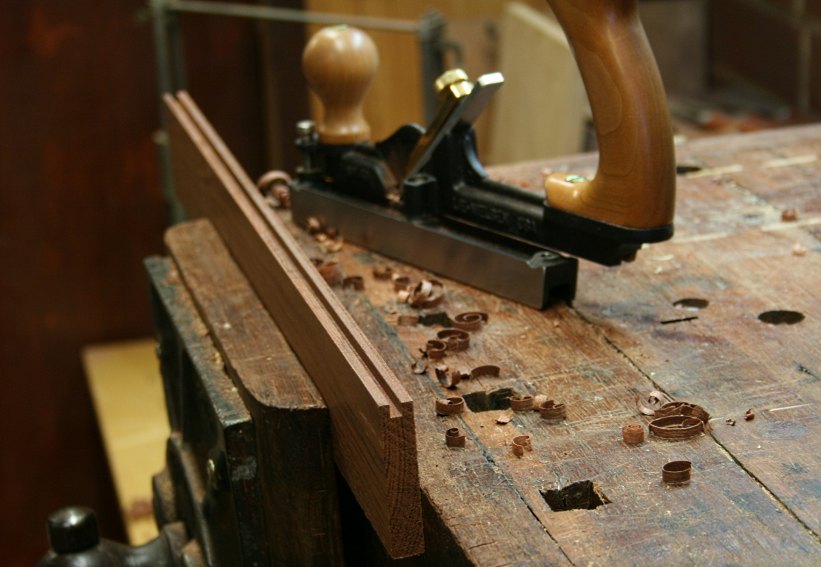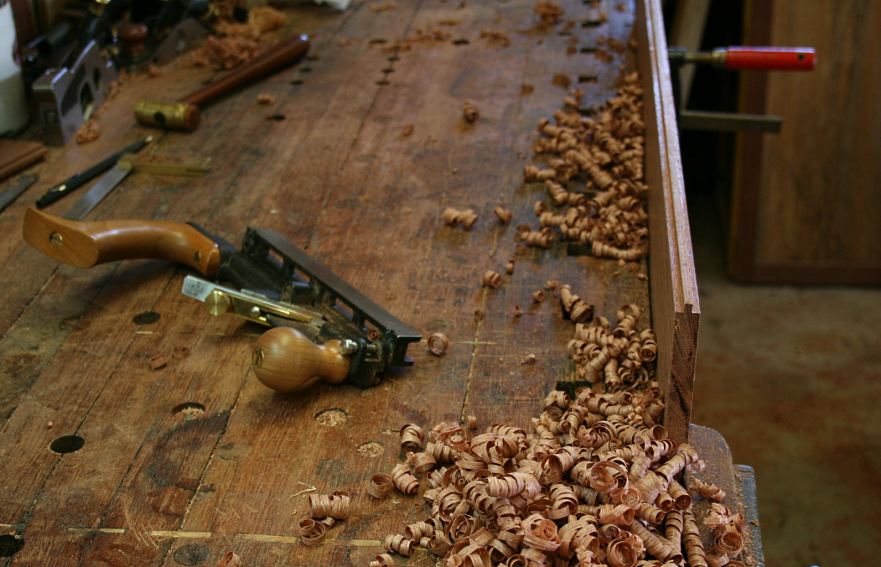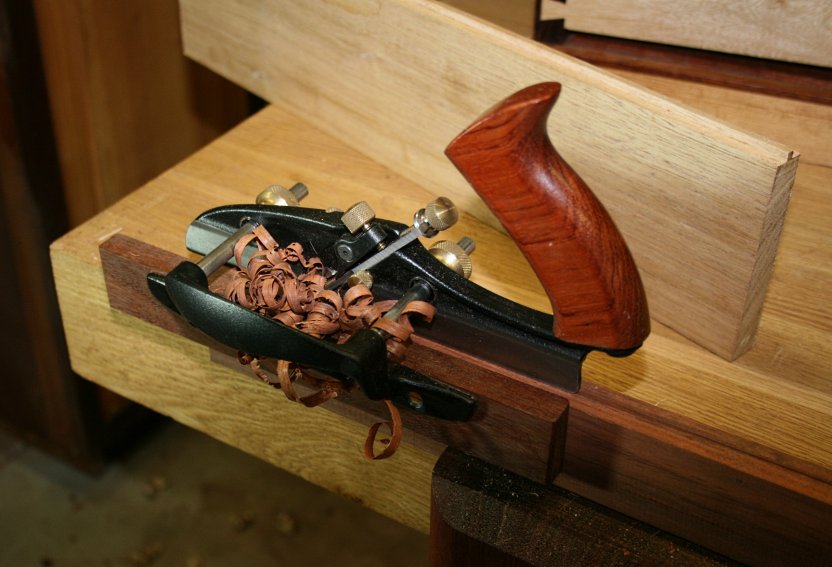A while ago, at the Woodfest event which used to be held at Westonbirt Arboretum, I was browsing the old tools on offer from Tony Murland on his stall there.
I was sufficiently tempted by a Stanley number 48 to buy one. Today I gave it its first proper work-out on a project, so I thought I would share some observations on its good and bad points.
According to Patrick Leach, at his guide to the whole range of Stanley planes the 48 is a good user plane, so I'd been looking for one for a while. In the flesh though it was the ingenuity of the design that convinced me.
The plane is designed to cut tongues and grooves on the edges of boards. The 48 is probably the more useful version, suitable for wood from ¾" up to 1¼". There is also a number 49, designed for use on thinner boards, from ⅜" to ¾"
It has a pair of irons, which stay set in place, but swapping from tonguing to grooving is immediate and simple - you just release a locking pin and swivel the fence to reveal or conceal one of the irons.
There is no scope to adjust the position, width or depth of the tongue or groove. You get the simplicity of a 5/16" width and depth, which is just fine for most purposes.
It's a clever design, patented in 1875 by Charles Miller and assigned to the Stanley company. (See http://www.datamp.org/patents/advance.php?id=8638&set=4 for more details.)
Here's a general view:

and here's the fence swinging round

This is the plane set up for cutting a groove:

and here both irons are ready to cut a tongue

When it's working nicely, the shavings spin out prettily on either side - which is achieved by having the tips of the cutter-holding clamps slightly flared out from the body as a mirror pair.

However, getting that performance does depend on mild wood and good grain direction. I was working on some nice easy cedar (I'll put more about it in the Projects section soon) which behaved well, but sometimes if there was a bit of reversed grain, this is what I got instead.

I was also taking fairly light shavings. You do need the shavings to be of the same thickness, which is a bit fiddly as the cutters have no built in adjustment. Having got them working together, I didn't really want to fiddle about with thicker or thinner settings.
Like any other fenced plane, you need to use your left hand to keep the fence pressed up to the work and the plane vertical, while your right hand does the pushing. I found that the nice wooden knob was not much use for this. If I just gripped it in my hand naturally, the locking knob for the fence was in the way and uncomfortable. It was better to rest my left thumb directly on the fence like this:

which is ok but not great. Later on, I found I could grip the knob like this by arching my hand over it

but that meant that the heel of my hand was resting on the edge of the fence - still not comfortable.
What was more of an issue was the shape of the metal handle. It's quite small, but has a horn on the top and on the bottom. I found the lower horn sticking into my hand annoyingly. Maybe if I used it all day I would get the required calluses, but I resorted to putting a glove on instead.
So, although it was working ok, I found it unpleasant to hold and use.
The other big disappointment was that with the plane set so fine, cutting the tongues and grooves was taking too long.
As an experiment, I swapped over to a Record 405 for cutting the grooves. (I expect a Stanley 45 would have been very similar, but I don't have one.) It was instantly better. As comfortable as putting my own shoes on after going bowling and having to wear those special shoes they make you use.
With the 405, the handle had no annoying and unnecessary lower horn. The whole tool was heavier and more solidly made. There was more length of skate ahead of the cutter, making the start of each cut simpler.
And best of all, I could take a decent thickness of shaving and speed through in half the time.

Of course, I could have used the 405 for the whole tongue and the groove job, but I had set out to make something, not just to experiment with different tools. I didn't have the time, timber or inclination to do a complete side by side comparison.
My interim conclusion is that although the design is clever, the plane is too light and too uncomfortable. I expect if I had used it more, I would have also discovered the annoyance of having to sharpen one cutter twice as much as the other, but I only kept going long enough to make these:

Maybe next time I will leave the 48 on the shelf and use the 405 for both cuts, but I suspect I will prefer using this lovely pair instead!



I was sufficiently tempted by a Stanley number 48 to buy one. Today I gave it its first proper work-out on a project, so I thought I would share some observations on its good and bad points.
According to Patrick Leach, at his guide to the whole range of Stanley planes the 48 is a good user plane, so I'd been looking for one for a while. In the flesh though it was the ingenuity of the design that convinced me.
The plane is designed to cut tongues and grooves on the edges of boards. The 48 is probably the more useful version, suitable for wood from ¾" up to 1¼". There is also a number 49, designed for use on thinner boards, from ⅜" to ¾"
It has a pair of irons, which stay set in place, but swapping from tonguing to grooving is immediate and simple - you just release a locking pin and swivel the fence to reveal or conceal one of the irons.
There is no scope to adjust the position, width or depth of the tongue or groove. You get the simplicity of a 5/16" width and depth, which is just fine for most purposes.
It's a clever design, patented in 1875 by Charles Miller and assigned to the Stanley company. (See http://www.datamp.org/patents/advance.php?id=8638&set=4 for more details.)
Here's a general view:

and here's the fence swinging round

This is the plane set up for cutting a groove:

and here both irons are ready to cut a tongue

When it's working nicely, the shavings spin out prettily on either side - which is achieved by having the tips of the cutter-holding clamps slightly flared out from the body as a mirror pair.

However, getting that performance does depend on mild wood and good grain direction. I was working on some nice easy cedar (I'll put more about it in the Projects section soon) which behaved well, but sometimes if there was a bit of reversed grain, this is what I got instead.

I was also taking fairly light shavings. You do need the shavings to be of the same thickness, which is a bit fiddly as the cutters have no built in adjustment. Having got them working together, I didn't really want to fiddle about with thicker or thinner settings.
Like any other fenced plane, you need to use your left hand to keep the fence pressed up to the work and the plane vertical, while your right hand does the pushing. I found that the nice wooden knob was not much use for this. If I just gripped it in my hand naturally, the locking knob for the fence was in the way and uncomfortable. It was better to rest my left thumb directly on the fence like this:

which is ok but not great. Later on, I found I could grip the knob like this by arching my hand over it

but that meant that the heel of my hand was resting on the edge of the fence - still not comfortable.
What was more of an issue was the shape of the metal handle. It's quite small, but has a horn on the top and on the bottom. I found the lower horn sticking into my hand annoyingly. Maybe if I used it all day I would get the required calluses, but I resorted to putting a glove on instead.
So, although it was working ok, I found it unpleasant to hold and use.
The other big disappointment was that with the plane set so fine, cutting the tongues and grooves was taking too long.
As an experiment, I swapped over to a Record 405 for cutting the grooves. (I expect a Stanley 45 would have been very similar, but I don't have one.) It was instantly better. As comfortable as putting my own shoes on after going bowling and having to wear those special shoes they make you use.
With the 405, the handle had no annoying and unnecessary lower horn. The whole tool was heavier and more solidly made. There was more length of skate ahead of the cutter, making the start of each cut simpler.
And best of all, I could take a decent thickness of shaving and speed through in half the time.

Of course, I could have used the 405 for the whole tongue and the groove job, but I had set out to make something, not just to experiment with different tools. I didn't have the time, timber or inclination to do a complete side by side comparison.
My interim conclusion is that although the design is clever, the plane is too light and too uncomfortable. I expect if I had used it more, I would have also discovered the annoyance of having to sharpen one cutter twice as much as the other, but I only kept going long enough to make these:

Maybe next time I will leave the 48 on the shelf and use the 405 for both cuts, but I suspect I will prefer using this lovely pair instead!










